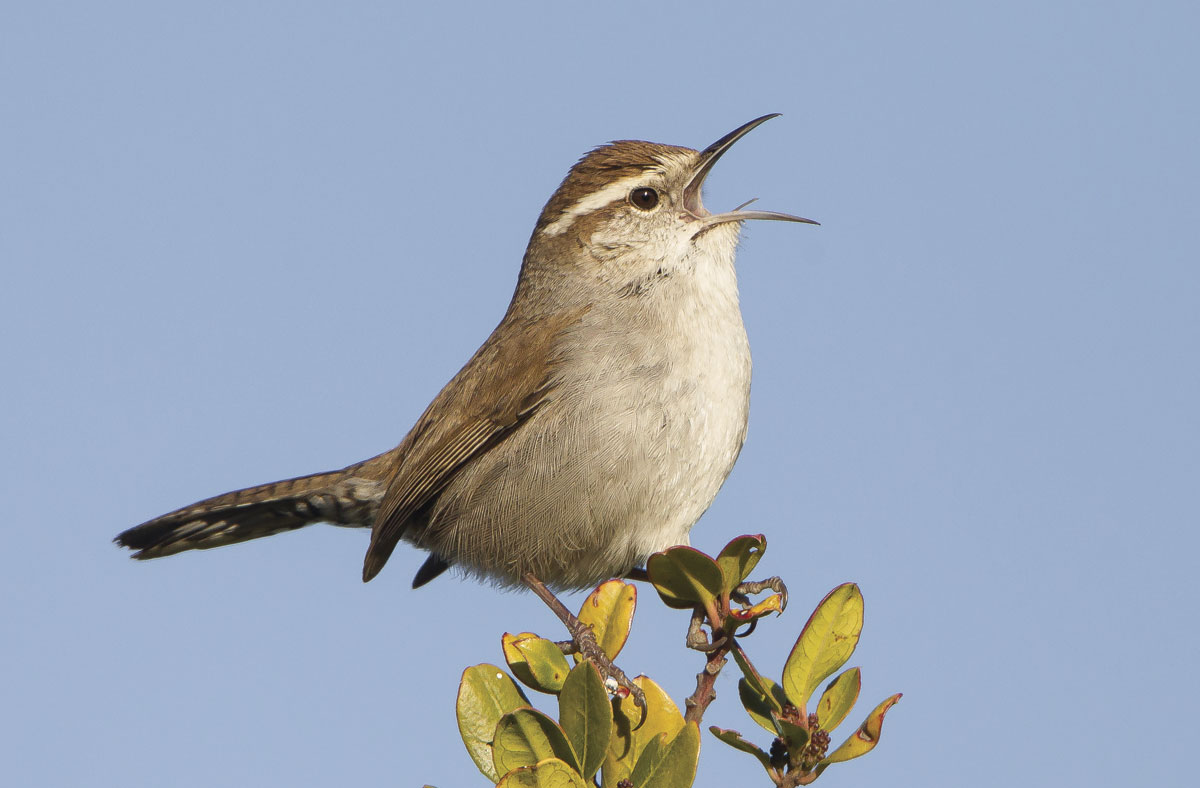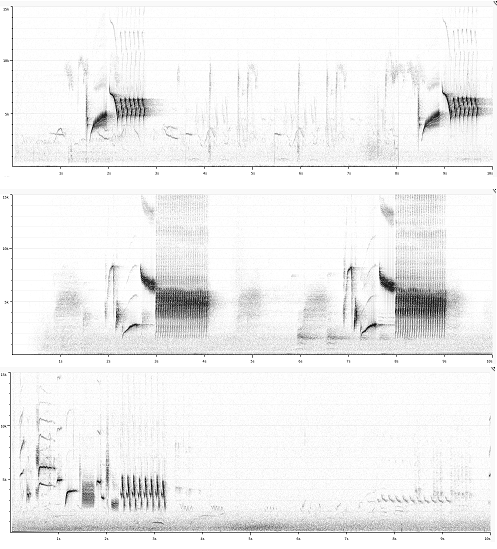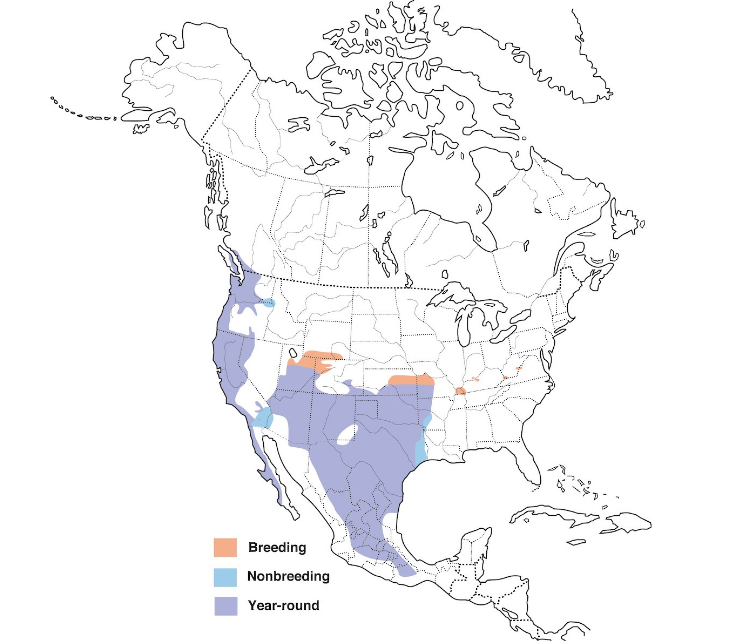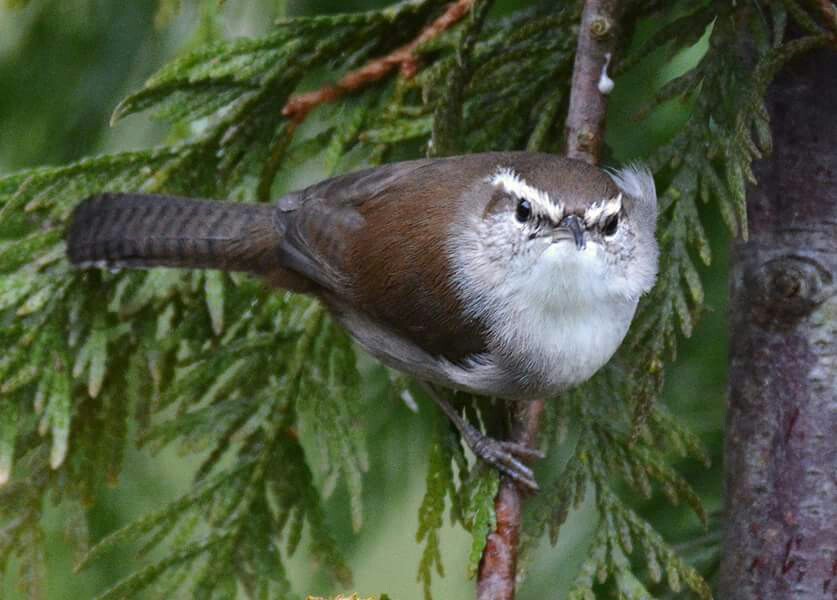
Figure 1) An adult Bewick’s Wren captured and banded at West Buttertubs Marsh, Nanaimo via VIU’s Bird Banding program (held by Hannah Hall, photo by Braden Judson).
The Bewick’s Wren is spotlighted in recent (and ongoing) research topics such as interspecific (between species) competition, song development and phylogeography (the change in species over geographic distance). In ornithological (science of birds) research citizen science often plays an important role; with avid bird-watching communities providing valuable and long-term monitoring data with respect to bird community abundance and composition. The Cornell Lab of Ornithology summarizes and distributes observational data via the website eBird. The data on eBird is far more numerous than any single group of researchers could achieve and is hence invaluable to the field of macroecology (large-scale ecosystem biology) (Jennifer Fee, 2012). This data is additionally opportune because the Bewick’s Wren can be a timely bird to study; due to its dense habitat and semi-elusive behaviour their range of vocal displays is more emphatically studied.

Figure 2) An adult Bewick’s Wren singing (notice the white eyebrow and downward curved bill) (Schroeder E, 2017).
While bird songs and calls have a subjective beauty, they can be quantified by using audio recording equipment. In the 1940’s bird songs were analyzed with a sensitive pin onto paper film, in which the physical vibrations of the call were visually represented on a graph called a “spectrogram” (Fish W, 1953). These graphs show the pattern of the call with frequency (kHz) on the y-axis (vertical) and time (seconds) on the x-axis (horizontal). An example of the Bewick’s Wren spectrogram is illustrated in Figure 3. As bird songs have variability (regionally, individually, temporally), spectrograms can be used to determine if two songs are produced by members of the same species. With advancing technology and equipment, spectrograms and bird song analysis can be sensitive enough to determine if the song is being produced by members of different species, or even different individuals within the same species (Petruskova T, et al. 2015). The Bewick’s Wren is a species that could (and has) benefit(ed) from detailed acoustic monitoring due to their vast vocal repertoire and elusive behaviour.
An individual Bewick’s Wren has a diverse library of calls, songs and whistles; however not every wren has the same library. Over their natural geographic range, there is significant change in calls and songs (Kroodsma D via Audubon). Factors such as learning behaviour, avifaunal (bird) diversity and competition influence each individual Bewick Wren’s repertoire of calls and songs. The Bewick’s Wren, like most songbirds, learn their call from neighboring conspecifics (other animals of the same species) (Soha J, et al. 2016). This type of spatially-influenced song learning often results in regional dialects (or “accents”), especially in non-migratory songbirds (Rivera-Gutierrez H, et al. 2010). As the Bewick’s Wren is a widespread songbird, studies have identified and quantified these regionally specific songs. Below (Soundclips 1-3 and Figure 3) is a demonstration of three songs from three regions; each with their own accent. These dialects can influence how a bird chooses a mate, potentially leading to isolated subpopulations or even new species (Edwards SV, et al. 2005). Studies of other birds, such as the White-Crowned Sparrow indicate that song dialects can persist in an isolated area for over 40 years between unrelated members of the same species (Nelson DA, et al. 2004). This indicates that birds who mimic their neighbors are favoured in a natural setting with respect to mate choice and establishing preferable territories.
Soundclip 1) Another male Bewick’s Wren singing in the southermost portion of ther range, Oaxaca, Mexico (Frank Lambert, 2015).
Soundclip 2) A male Bewick’s Wren from Brier, Washington singing at the northwestern edge of their territory (most similar to the songs we hear on Vancouver Island!) (Tayler Brooks, 2010).
Soundclip 3) A male Bewick’s Wren singing in the easternmost corner of their natural range, Las Vegas, Nevada (Mike Nelson, 2010).

Figure 3) Sonogram representations of each Bewick’s Wren song: Top (Oaxaca, Mexico), Middle (Brier, Washington) and Bottom (Las-Vegas, Nevada). Despite background noises, subtle details in the pattern of each call is different. (recall, y-axis is kHz (frequency) and x-axis is time (seconds)). While certain calls parameters vary, the overall pattern is very similar.
In the case of the Bewick’s Wren, the young are typically dispersed from their nest and establishing their own territories and calls after about 60 days. These young birds will disperse anywhere between 0.1 and 3.0 km, and will initially establish their territory by imitating neighboring wren calls (Kroodsma D, 1974). It is advantageous for these birds to mimic their neighbors, as established mates will interpret the bird as being well adapted to the area. This style of reproductive selection will ensure that the Bewick Wrens who mimic their neighbors are most likely to produce the most offspring. This hypothesis has been tested by taking related nest-mates and scattering them throughout a region. After approximately 60 days, these wrens had established their own calls that were similar to their neighbors calls, and significantly dissimilar to their brothers and sisters’ (Kroodsma D, 1974). This dispersal technique and mimicry advantage are directly influenced by habitat fragmentation. As the Wren’s habitat is cut into smaller chunks, the species are less able to disperse and learn new, neighboring calls.Prolonged outcomes of habitat fragmentation include inbreeding, population decline or in extreme cases: species extinction (Rivera-Gutierrez H, et al. 2010).

Figure 4) Natural geographic range of the Bewick’s Wren (Cornell Lab of Ornithology, 2017)
The size of an individual wren’s vocal library can be the outcome of adjacent avifaunal biodiversity. Studies have shown that Bewick Wrens in habitat that also contains numerous other wrens will have a smaller vocal repertoire. This way the singing Bewick’s Wren is easily recognizable and does not waste their time attracting different species or non-suitable mates. These wrens will cycle between several songs, repeating each a few times before changing their display. However, Bewick Wrens in areas with few other wrens will typically have a more diverse series of calls and songs as they aim to be unique and cannot be confused with other wrens. Data suggests that low diversity wren populations result in the Bewick’s Wrens adapting different calls in attempt to sound better, louder or more complex than their neighboring calls (Kroodsma D, 1977 and Kroodsma D, 1984).
The Bewick’s Wren proves itself to be a good example for song analysis as they are widespread, beautiful and variable. The Bewick’s Wren has offered insight into songbird learning, geographic song isolation, speciation, mate choice and vocal competition. This species has many potential applications within the worlds of behavioural ecology, population ecology and evolution.

Figure 5) A grumpy looking Bewick’s Wren from Washington State, seen perching on a thin cedar branch (Bird is the Word).
Literature Cited
1) Edwards SV, Kingan SB, Calkins JD, Balakrishnan CN, Jennings WB, Swanson WJ and Sorenson MD. 2005. Speciation in birds: Genes, geography and sexual selection. Proc Natl Acad Sci U S A, 102: 6550-6557. doi: 10.1073/pnas.0501846102
2) Fee J and Trautmann N. 2012. Connecting to your community through bird and citizen science. Science scope, 36: 62-68.
3) Fish WR. 1953. A Method for the Objective Study of Bird Song and Its Application to the Analysis of Bewick Wren Songs. Condor, 55: 250-257. doi: 10.2307/1365036
4) Kroodsma DE. 1977. Correlates of Song Organization Among North American Wrens. Amer Nat, 111: 289-301.
5) Kroodsma DE. 1984. Geographic variation in songs of the Bewick’s wren: a search for correlations with avifaunal complexity. Behav Ecol Sociobiol, 16: 143-150.
6) Kroodsma DE. 1974. Song Learning, Dialects, and Dispersal in the Bewick’s Wren. Anim Psych, 35: 352-380. doi: 10.1111/j.1439-0310.1974.tb00451.x
7) Nelson DA, Hallberg KI and Soha JA. 2004. Cultural Evolution of Puget Sound White-Crowned Sparrow Song Dialects. Ethology, 110: 879-908. doi:10.1111/j.1439-0310.2004.01025.x
8) Petruskova T, Pisvejcova I, Kinstova A, Brinke T and Petrusek A. 2015. Repertoire-based individual acoustic monitoring of a migratory passerine bird with complex song as an efficient tool for tracking territorial dynamics and annual return rates. Methods Ecol Evol, 7: 274-284. doi:10.1111/2041-210X.12496
9) Rivera-Gutierrez HF, Matthysen E, Adriaensen F and Slabbekoorn H. 2010. Repertoire Sharing and Song Similarity between Great Tit Males Decline with Distance between Forest Fragments. Ethology, 116: 951-960. doi: 10.1111/j.1439-0310.2010.01813.x
10) Soha JA, Poesel A, Nelson DA and Lohr B. 2016. Non-Salient Geographic Variation in Birdsong in a Species That Learns by Improvisation. Ethology, 122:343-353. doi:10.1111/eth.12474
This is really interesting! I can never recognize the different songs that these birds make. I was wondering how often do they cycle between songs and why do they need such a big repertoire?
They transition between their song and buzz when the environment calls for it. When female wrens are nearby the male will sing songs; however, when there are competing males or other disruptive animals (predators for example) nearby they will scold them by buzzing repeatedly. As far as I know, their song diversity is the result of females preferentially choosing males that are capable of more complex and varied songs. This allows males to ‘outcompete’ other males and assert dominance, without the expense (and risk) of a physical fight.
Well done Braden! Nice use of media to illustrate the variation and similarities in BEWR song.